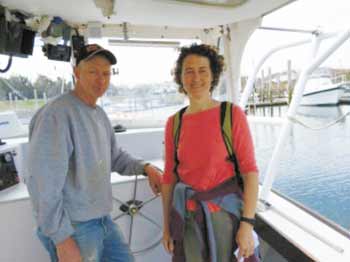Giving Safety a Competitive Advantage
Increasing PFD Use Among Lobstermen

Rebecca Weil, right. NEC, “The singular goal of this research project is to increase wear rates of PFDs among northeast lobstermen and increase their chance of survival following a fall overboard.”
Press Release The rates of commercial fishing fatalities are estimated to be 31 times higher than the average industrial fatality rate. Falls overboard are the most frequent cause of death in the Northeast lobster commercial fishing fleet, according to the National Institute of Occupational Safety and Health (NIOSH) Center for Maritime Safety and Health Studies, and could largely be prevented with the regular use of personal flotation devices (PFDs). Working together with Northeast lobstermen, the goal is to address concerns about PFDs. This project will be led by the Northeast Center for Occupational Health and Safety: Agriculture, Forestry and Fishing (NEC), in conjunction with Fishing Partnership Support Services (FPSS), Lobstermen in Maine and Massachusetts, and PFD manufacturers.
Fishermen will be asked to try out existing, commercially available PFDs and to share what they like or don’t like about these designs and how well they are able to work in them. They will also be asked to share ideas on how PFDs can incorporate value-added features that provide additional benefits besides safety. This information will be used to identify or adjust existing designs whenever possible and fishermen will be given opportunities to try out these new and improved designs.
The singular goal of this research project is to increase wear rates of PFDs among northeast lobstermen and increase their chance of survival following a fall overboard (FOB). This work is not regulatory, it is responsive to feedback from lobstermen about the challenges they have with wearing PFDs. By giving lobstermen a primary role in the research process, we hope to develop safety solutions that address lobstermen’s barriers to PFD use and to develop solutions that make safety cost-effective and easy.
Although much has been learned regarding PFD barriers and potential motivators, there has been very little research on the impact of interventions that address these barriers and motivators in commercial fishing. Our research will evaluate the effectiveness of an intervention that incorporates social marketing principles and other novel approaches to increase the use of proven safety devices. If this approach proves successful, similar methods could be used to increase the use of other safety devices such as hatch-monitoring systems or e-stop technology in the commercial fishing industry, NIOSH “safe by design” practices for fall prevention in construction or lifts and safe patient-handling practices in healthcare.
Faculty and Facility: Julie Sorensen (Director, NEC); Research Coordinator: Rebecca Weil (NEC); Research Coordinator: Liane Hirabayashi (NEC); Research Assistant: Jessica Echard (NEC)
In partnership with Fishing Partnership Support Services: www.fishingpartnership.org FPSS is a primary source of health and community support for commercial fishermen and their families and has been a core component of the fishing community since 1997, as well as a key NEC partner in recent years.
Previous research by the NEC led to the development of this project. Read about the Use of Floatation Devices in the Northeast Lobster Fishing Industry here: http://www.necenter.org/fishing/research/
